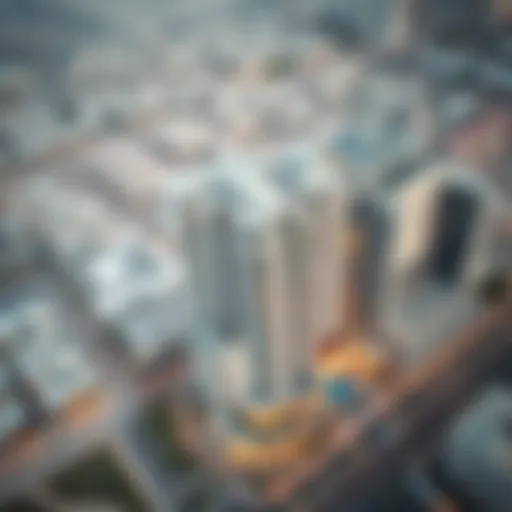Architectural Brilliance of Qasr Al-Hind in Dubai
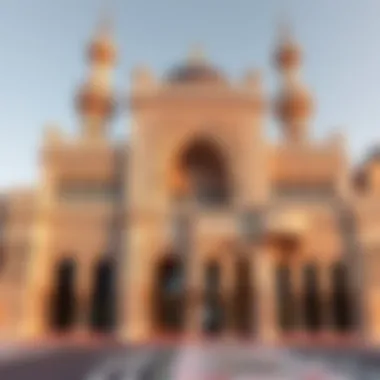
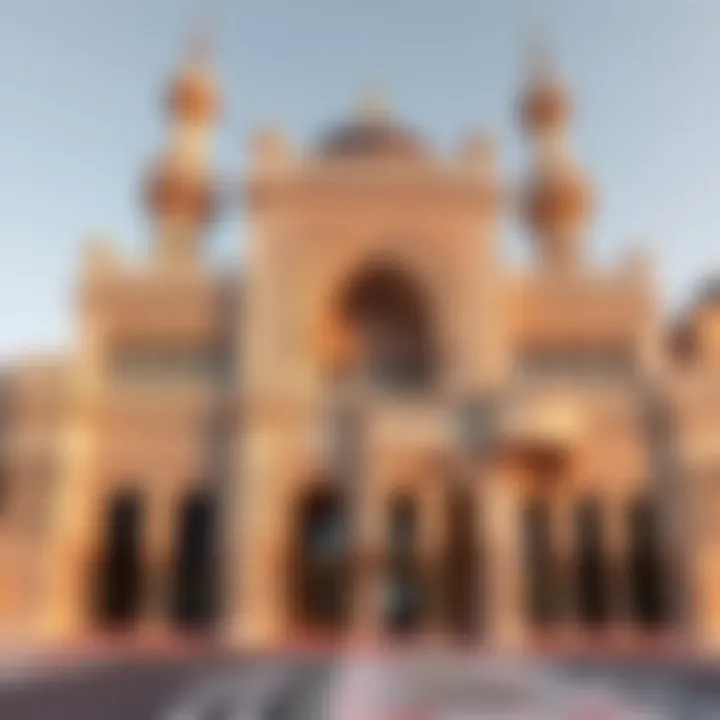
Prologue
Qasr Al-Hind stands as a testament to Dubai's architectural modernity, embodying a unique blend of cultural heritage and contemporary design. Its structure serves not only as a visual landmark but also as a reflection of the economic vigor that defines the real estate market in Dubai today. As the city burgeons, this intricate building offers a lens through which one can analyze both the architectural choices made and the driving forces behind the local property dynamics.
In this exploration, we will delve deep into the various aspects that make Qasr Al-Hind a prominent figure in Dubai’s landscape. The discussion will span across its unique design, the historical narratives encapsulated within its walls, and the prospective market trends that influence its relevance in the thriving real estate sector.
The article seeks to provide an understanding that resonates with diverse stakeholders, from investors and real estate agents to everyday buyers looking to navigate the complex property market. By shedding light on the architectural significance and the socio-economic underpinnings of Qasr Al-Hind, readers will come away with a richer appreciation of not just the building itself but also of how architectural brilliance informs and influences market behavior in Dubai.
Market Insights
Current Trends in Dubai Real Estate
The real estate market in Dubai is characterized by rapid fluctuations and continual growth. Notably, there has been a prominent surge in demand for luxury properties, attributed largely to an influx of expatriates and investors looking for lucrative opportunities. Recently, off-plan properties have garnered attention, as buyers seek to capitalize on the lower initial investment while accommodating potential for significant returns upon completion.
Factors such as government policies promoting foreign investments, the introduction of long-term visas, and the hosting of major events like Expo 2020 have invigorated buyer confidence. The combination of a resilient economy and attractive property pricing has made areas around Qasr Al-Hind particularly appealing for those considering investment.
Economic Factors Impacting Property Values
Several economic factors are currently shaping the property values in Dubai, with Qasr Al-Hind being no exception. First, supply and demand dynamics play a pivotal role. With a robust construction pipeline, the influx of new projects is introducing greater competition and influencing price strategies across the board.
Another influential aspect is the macroeconomic environment, particularly oil prices and overall economic stability. As the UAE diversifies its economy, moving away from oil dependency, we see investments flooding in from various sectors, further stimulating growth in the property market.
Historical Context of Qasr Al-Hind
Understanding the historical context of Qasr Al-Hind is crucial not only in grasping its architectural brilliance but also its place within the tapestry of Dubai's urban landscape. History lays the foundation upon which this magnificent structure stands, reflecting the evolution of both Dubai as a city and the ideals that shaped its cultural identity.
Origins of Qasr Al-Hind
The genesis of Qasr Al-Hind can be traced back to the early 20th century, a time when Dubai was transitioning from a modest fishing village into a burgeoning trade hub. Originally built as a royal residence, Qasr Al-Hind served as a symbol of power and prestige, showcasing the wealth that was beginning to flow into the region through pearl diving and trade. The design of the building itself embodies the influences of traditional Arabian architecture, characterized by intricate detail and a deep respect for the surrounding environment.
As the nation prepared to embrace modernization, the structure evolved into a notable landmark that captured the spirit of an emerging Dubai, where the past harmoniously coexisted with the aspirations of the future.
Architectural Evolution
Qasr Al-Hind did not remain static over the decades; rather, it underwent significant transformations that reflect both aesthetic and functional shifts. Each phase of renovation emphasized the importance of preserving its core architectural features while integrating contemporary influences. The blend of modern materials with historical design principles illuminates the dynamic nature of the building’s architecture.
Notably, throughout the 1980s and 1990s, modifications brought about a more lavish feel, incorporating ornate decorations that appealed to a growing affluent class. This adaptability highlights a broader trend in Dubai's architectural landscape, where buildings continuously evolve to meet the changing demands of society without losing their intrinsic historical value.
Cultural Significance in Dubai
Beyond its architectural allure, Qasr Al-Hind holds a deep-seated cultural significance for the people of Dubai. It stands as a testament to the Emirati heritage and is tied to various local traditions and stories passed down through generations. The building often serves as a venue for important cultural events, showcasing local artisans, music, and food, thereby facilitating engagement between the city's diverse communities.
Moreover, its role in the narrative of Dubai’s growth is paramount; it reminds residents and visitors alike of the rich history that precedes the gleaming skyscrapers and luxurious lifestyle associated with the modern city. As such, Qasr Al-Hind isn’t merely a relic of the past, but is woven into the fabric of contemporary life, cherishing and celebrating the essence of what it means to be part of Dubai.
"History has a way of haunting the present; structures like Qasr Al-Hind allow that history to breathe and resonate with us still."
In this exploration of historical context, we see that Qasr Al-Hind is intertwined with the cultural and societal evolution of Dubai. It serves as a marker of growth and change, underscoring the significance of maintaining a balance between progress and tradition.
Architectural Design and Features

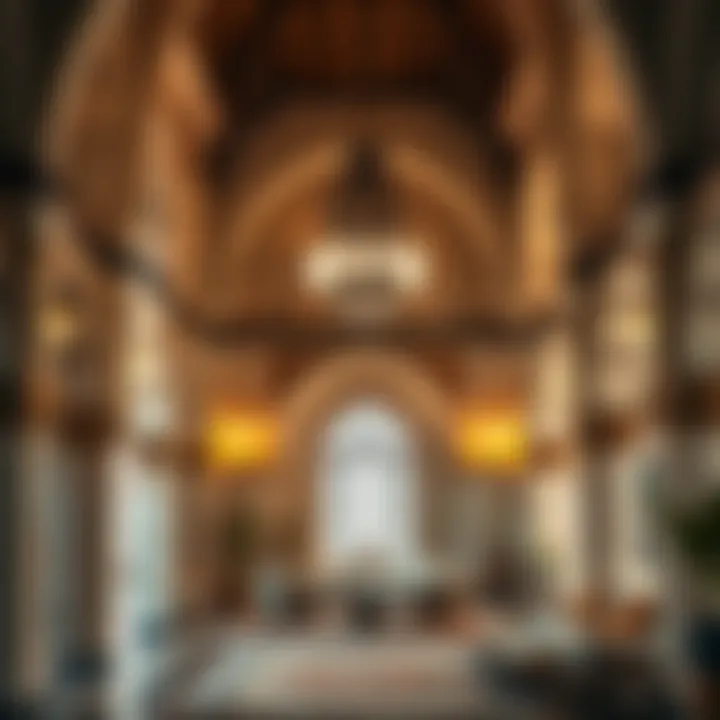
The architectural design of Qasr Al-Hind goes beyond surface appearances; it reflects the layered history and aspirations of Dubai. In this section, we delve into its design philosophy, notable elements, and landscaping. Each facet plays a vital role in encapsulating the essence of this iconic structure. By examining these architectural features, we can better appreciate their significance in shaping cultural landscapes and real estate dynamics in the area.
Design Philosophy
The design philosophy behind Qasr Al-Hind is marked by a blend of tradition and modernity. This approach not only provides aesthetic appeal but also addresses functional needs. The architects aimed to create a space that resonates with the historical context yet meets contemporary standards. The open plan allows for natural light to pour in, merging indoor and outdoor spaces effectively.
One of the underlying principles is the emphasis on irradicating nostalgia, making visitors connect emotionally with the site. The utilization of local design motifs alongside modern materials exemplifies how heritage can inspire innovative architecture. This dualistic philosophy offers investors a glimpse into a market where heritage tourism meets luxury living.
Notable Architectural Elements
Material Usage
The materials chosen for Qasr Al-Hind reveal much about the environment and crafting skills in the region. The dominant usage of limestone not only reflects local geology but also possesses thermal insulation properties, making it ideal for Dubai's climate. Additionally, the incorporation of glass elements enhances the building's transparency, cleverly juxtaposing solidity with fluidity.
- Key Characteristic: Sustainability and durability of materials used ensures longevity.
- Unique Feature: The choice of limestone makes up the striking façade that ages gracefully.
- Advantages: Its insulating properties lend energy efficiency to the building, reducing long-term costs for owners.
Color Palette
The color palette of Qasr Al-Hind is a conscious reflection of the desert landscape. Soft earth tones, accented by vibrant splashes of bluish greens and warm terracotta, harmonize seamlessly with the surroundings. This thoughtful choice creates an inviting atmosphere that contrasts beautifully with urban chaos.
- Key Characteristic: Earthy tones resonate with the natural environment, making it blend effortlessly.
- Unique Feature: The interplay of colors shifts with sunlight, giving the structure a dynamic personality.
- Advantages: The palette encourages a sense of serenity, appealing to both residents and visitors alike.
Design Symmetry
Design symmetry serves as a hallmark of Qasr Al-Hind's architectural integrity. The symmetrical layout not only enhances its visual appeal but also signifies balance—a profound concept in many cultures. It fosters a sense of calm, inviting exploration through thoughtfully arranged spaces.
- Key Characteristic: The symmetrical design promotes symmetry in emotional and physical responses.
- Unique Feature: It allows for optimal natural light penetration, contributing to energy savings.
- Advantages: This symmetry limits confusion and enhances wayfinding, proving beneficial for both residents and tourists.
Landscaping and Surroundings
The landscaping surrounding Qasr Al-Hind is meticulously curated to complement its architectural beauty. Native plants adorn the surroundings, creating pockets of green that act as natural air purifiers. The gardens are not just aesthetic; they serve as social spaces fostering community interactions.
Besides, the positioning of water features against the arid background brings in cooling effects. Pathways, dotted with benches and art pieces, encourage leisurely strolls and engage visitors to connect deeply with the space. This micro-ecosystem around the palace evolves continuously, echoing the growth and aspirations of Dubai itself.
By understanding the architectural design and features of Qasr Al-Hind, one gains insight into the broader implications for Dubai's real estate landscape. Each design choice contributes meaningfully to the cultural narrative that defines this remarkable place.
Qasr Al-Hind and Its Role in Real Estate
Qasr Al-Hind stands as a beacon in the ever-evolving real estate landscape of Dubai. Its architectural magnificence and historical significance contribute not only to the aesthetic charm of the region but also to its economic vitality. As a pivotal landmark, the building influences various dynamics, from property values to community appreciation. Investors and developers alike find themselves drawn to its unique character and potential, making it a cornerstone for real estate discussions in this fast-paced market.
Impact on Local Property Market
The presence of Qasr Al-Hind has a significant impact on local property prices. Properties in close proximity to this landmark often see increased demand due to its cultural weight and allure. This phenomenon is not uncommon; historic buildings attract buyers who are looking for more than just a home – they seek a lifestyle intertwined with a story.
As residents flock to the area, amenities around Qasr Al-Hind have flourished. Retail hubs, cafes, and entertainment venues sprout up, enhancing the livability of the neighborhood. This ripple effect raises property values, creating a compelling argument for investment. Real estate professionals refer to this as the 'halo effect' where the presence of a prestigious building raises neighborhood standards and desirability. Additionally, properties that maintain a view of Qasr Al-Hind command premium prices, further illustrating its positive influence on the market.
Investment Opportunities Nearby
Investors looking at the Qasr Al-Hind area will discover a wealth of opportunities that extend beyond direct residence. With commercial spaces becoming more sought after, the demand for development is palpable. Property developers are keen to explore mixed-use projects that capitalize on the foot traffic that Qasr Al-Hind attracts.
For instance, nearby land parcels are often viewed as prime opportunities for hotels, retail developments, and even cultural spaces. Investors can also consider residential projects that cater to professionals who are drawn to the vibrant lifestyle Qasr Al-Hind offers. Proximity to this architectural gem not only enhances property appeal but also promises substantial returns in an increasingly competitive market.


Projected Future Developments
Looking ahead, the landscape surrounding Qasr Al-Hind is set to experience significant evolution. Authorities in Dubai continually invest in infrastructure that complements the charm of this iconic structure. The ongoing urban regeneration initiatives promise improved transport links and additional public amenities that will undoubtedly strengthen the allure of the area.
Anticipated projects include expanded parks and recreational facilities that aim to integrate Qasr Al-Hind’s historical essence with modern urban living. As a result, property values are expected to continue their upswing, attracting both local and global investors. Moreover, with growing interest in sustainability, future developments may reflect eco-friendly practices while still preserving the architectural integrity of the area, thus appealing to the environmentally conscious buyer and investor alike.
"The growth around Qasr Al-Hind isn't just about buildings; it's about creating a community that respects the past while thriving in the present."
Ultimately, the role of Qasr Al-Hind in real estate is multifaceted. As trends shift, maintaining awareness of its significance in the market could yield fruitful results for those willing to engage with this exceptional landmark.
Anecdotes and Lesser-Known Facts
Anecdotes and lesser-known facts are crucial in shaping our appreciation of Qasr Al-Hind. They provide texture to the architectural narrative, allowing us to peek behind the curtain, so to speak. As the saying goes, every building has a story to tell, and this is particularly true for Qasr Al-Hind. It's not just the bricks and mortar that define its significance, but also the human experiences intertwined with it. These stories enrich our understanding and allow for a multifaceted perspective on the structure’s place in Dubai’s historic and modern landscape.
Interesting Stories from Residents
Residents of the vicinity have experienced Qasr Al-Hind in ways that surpass mere observation. Take, for example, Fatima, a community leader whose family has lived nearby for generations. She often shares how her grandmother recounted, “In the afternoons, we could hear the call to prayer echoing off the walls. It was as if the very stones were singing.” This auditory memory wraps the building in a warm nostalgia, reflecting how integral it was to the daily lives of its neighbors.
Such accounts stimulate a sense of shared history among locals. They create threads that link past and present. For many, Qasr Al-Hind isn’t merely an architectural gem; it represents a repository of shared experiences, passing down moments that form a collective identity. Whether it’s hosting festive gatherings during Ramadan or being a backdrop for impromptu neighborhood events, the castle continues to thrive as a lively community hub even today.
Additionally, tales of artists finding inspiration within its walls abound. Local painters often depict the Qasr in their work, capturing not just its likeness but the spirit it embodies. Some have even ventured to create night-time murals illuminated by moonlight. This melding of modern artistry with historic architecture creates an intricate tapestry, emphasizing how the building inspires both nostalgia and innovation.
Historical Events Associated with Qasr Al-Hind
Diving deeper, we uncover some historical events that have left a mark on Qasr Al-Hind. One notable moment occurred during the Emirati festival of Al-Hag al-Jadid. The festival is a celebration of local culture, and in one year during the early 2000s, a famous poet spilled ink in honor of the Qasr, reciting verses that linked its history to the broader landscape of Emirati traditions.
Such events illustrate how Qasr Al-Hind has served as a backdrop for significant cultural expressions. It's as if the walls themselves become witnesses to the evolution of Dubai's societal values over the decades. This dynamic dynamic role in local cultural practices highlights its relevance beyond architectural beauty.
Moreover, many residents recall the 2012 restoration effort that took more than a year to complete. During this time, the building became a focal point for discussions about conservation and heritage. Community outreach programs educated people about its significance, reshaping how the city viewed its historical structures.
Visiting Qasr Al-Hind Today
Visiting Qasr Al-Hind is more than just an outing; it is immersing oneself in the rich tapestry of Dubai’s culture, history, and architectural wonder. For the discerning traveler or the real estate aficionado, this iconic site stands as a testament to the city’s evolution. The experience of visiting this structure can significantly inform one’s understanding of Dubai’s real estate market and the unique features that make it a top destination.
Accessibility and Transportation
Getting to Qasr Al-Hind is generally straightforward, thanks to Dubai's well-developed transport infrastructure. Visitors can opt for various transportation modes, catering to diverse preferences and budgets.
- Metro: The closest metro station is Al Jafiliya, a stone's throw away from the site. From there, one can catch a short taxi ride or even walk.
- Buses: Several bus routes wind through the area, offering a cheaper alternative for those looking to save a few dirhams. The bus stops are well marked, making navigation a breeze.
- Taxis and Ride-Hailing: For those who prefer a more direct route, taxis or ride-hailing services such as Uber or Careem are very popular. It's worth noting that traffic around this area can be thick during peak hours; planning ahead is wise.
- Parking Facilities: If you're driving, Qasr Al-Hind provides ample parking, making access convenient. Just make sure to check for any parking fees.
This mix of accessibility options ensures that visitors can plan their trips to Qasr Al-Hind with ease, minimizing hassles.
Cultural Activities and Exhibitions
Once inside, the experience at Qasr Al-Hind unfolds like a beautifully crafted tale. The site regularly hosts a range of cultural activities and exhibitions, aimed at engaging both tourists and locals.
- Art Installations: Often, contemporary artists showcase their works within the grounds, blending modern art with historical architecture. Visitors can stroll through and appreciate the way these two worlds collide.
- Cultural Festivals: Throughout the year, Qasr Al-Hind becomes a hub for various cultural festivals. These events often feature local crafts, culinary exhibitions, and performances that celebrate Emirati heritage.
- Guided Tours: For a deeper understanding, guided tours led by knowledgeable curators provide anecdotes and historical insights that add another layer to the visit. Tours can range from a quick overview to more detailed explorations of architectural techniques.
- Workshops: Some days, the palace opens its doors to workshops where participants can learn traditional Emirati crafts, such as weaving or pottery-making.
Visiting Qasr Al-Hind thus offers much more than a visual experience; it invites participation and encourages interaction with the region's myriad cultural narratives.
"Qasr Al-Hind isn't just a building; it represents a crossroads of tradition and modernity, inviting all who enter to explore its story."

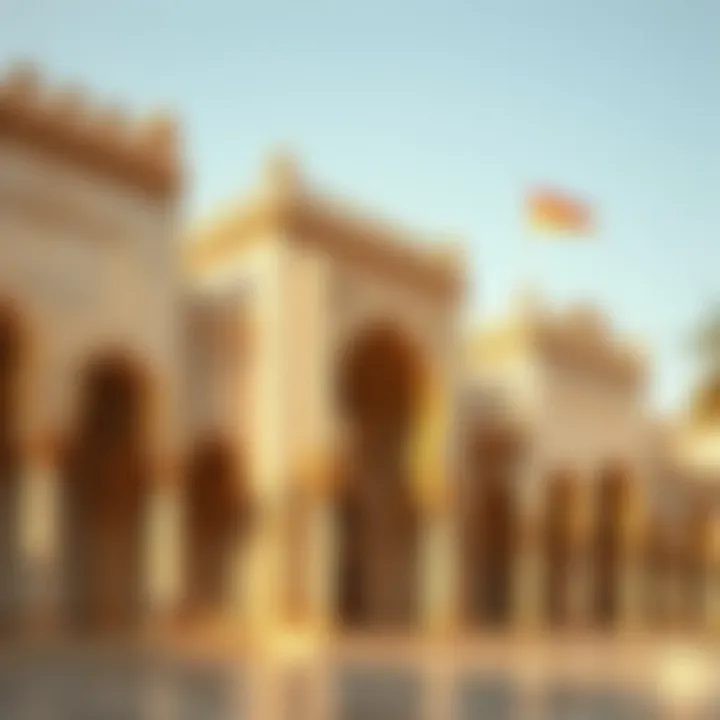
In summary, a visit to Qasr Al-Hind is not just another tick on the travel checklist but a deep dive into the cultural essence of Dubai. Whether one arrives by metro, bus, or car, the rich activities that unfold within its walls ensure every visit is both enlightening and memorable.
Comparative Analysis with Other Architectural Structures
In contemplating the architectural essence of Qasr Al-Hind, it presents a unique opportunity to compare its features with other notable structures. This analysis sheds light on the architectural discourse shaping Dubai’s skyline as well as regional characteristics, providing insight into the evolution of not only Qasr Al-Hind but also the architectural narrative of the region itself.
Similarities with Regional Architecture
The characteristics of Qasr Al-Hind reflect elements commonly found in regional architecture, particularly those emanating from the Arabian Peninsula. For instance, elements such as intricate mashrabiya screens can be seen framing windows, which offers a blend of privacy and ventilation. This design choice is not just aesthetically pleasing; it also serves functional purposes reminiscent of traditional Middle Eastern homes.
- Arched doorways: Much like other regional structures, Qasr Al-Hind features grand arches. This architectural choice is not merely decorative; it speaks to the spatial dynamics typical of Islamic architecture, where curves dominate to convey elegance and peace.
- Natural materials: The use of local stone mirrors the vernacular practices seen across Qatar, Saudi Arabia, and the broader Gulf States. A connection to nature can be felt in how the building seems to emerge organically from its surroundings.
- Courtyard designs: Similar to the structures of the old city of Dubai, the interior layout promotes community interaction. This embodies the spirit of togetherness that is prevalent in regional designs, often fostering a sense of belonging for inhabitants and visitors alike.
While there are undeniably close ties to local architectural traditions, the Qasr Al-Hind adapts them for modern sensibilities, bridging the past with present needs.
Contrasts with Modern Buildings
In stark contrast, Qasr Al-Hind stands as a sentinel amidst the sea of ultra-modern skyscrapers that flood Dubai’s skyline. Where one might encounter glass and steel marvels, Qasr Al-Hind chooses to embody a more traditional narrative, reflecting a slower, more contemplative architectural rhythm. The juxtaposition is telling:
- Materiality: Unlike the sleek glass facades that many modern buildings flaunt, Qasr Al-Hind employs more tactile materials such as stone and traditional plaster. This fosters a connection with the historical artistry of the region and emphasizes texture over visual slickness.
- Scale: Many contemporary buildings boast towering heights and expansive floors, but Qasr Al-Hind embraces a more human scale. The proportions feel inviting and warm, offering a stark contrast to the monolithic modernity of structures such as the Burj Khalifa.
- Cultural reflections: Qasr Al-Hind serves as a cultural anchor, a bastion of history within a city often criticized for its rapid development. Its design reflects a narrative of continuity, whereas modern buildings often seem to project a future detached from their origins.
"In the rush of progress, the value of a building such as Qasr Al-Hind reminds us to look back and understand where we come from."
By analyzing these similarities and contrasts, one can appreciate not only the distinct features of Qasr Al-Hind but also the broader architectural trends at play in both the region and the modern landscape. Ignoring the past often leads to a sterile future, while structures like Qasr Al-Hind champion heritage and contextual relevance amidst Dubai's forward-looking aspirations.
Reflections on the Future of Qasr Al-Hind
The future of Qasr Al-Hind holds a significant place in discussions surrounding its legacy, preservation, and urban relevance. This iconic structure not only represents a rich historical narrative but is also poised to adapt and evolve in a fast-paced environment like Dubai. As societal values shift and urban landscapes develop, understanding the trajectory of Qasr Al-Hind becomes paramount for stakeholders involved in real estate, culture, and architecture in Dubai.
Preservation Efforts
Preservation efforts surrounding Qasr Al-Hind illustrate the delicate balance between maintaining historical integrity and accommodating modern demands. Various organizations, including the Dubai Culture and Arts Authority, have initiated programs designed to protect the building’s structure while promoting its significance. Preservation can take many forms:
- Architectural Restoration: Implementing techniques that stay true to traditional craftsmanship while using modern materials to enhance durability.
- Educational Programs: Hosting workshops and lectures that attract interest in Qasr Al-Hind, thus reinforcing its historical context within the community.
- Engagement with Conservation Experts: Collaborating with specialists ensures adherence to best practices in maintaining the site’s integrity, allowing the stories embedded within its walls to be preserved for future generations.
The importance of these efforts cannot be understated; they ensure that the building remains a legitimate testament to the rich cultural tapestry of Dubai. As cities continue to expand, finding sympathetic and thoughtful ways to keep such structures alive becomes increasingly essential.
Community Engagement and Initiatives
Engaging the community in initiatives related to Qasr Al-Hind fosters a sense of ownership and responsibility towards cultural heritage. Local residents, businesses, and educational institutions can play a key role in sustaining the relevance of this historical site. Initiatives include:
- Cultural Festivals: Hosting events that celebrate local history and encourage participation from various demographics within the community. These events can enhance awareness and appreciation for the architectural beauty of Qasr Al-Hind.
- Volunteer Programs: Involving residents in maintenance and restoration activities cultivates a communal bond around the shared responsibility of preserving local heritage.
- Partnerships with Schools: Educating the younger generation about the significance of Qasr Al-Hind through specialized partnerships with local schools to develop historical curricula around this monument.
Ultimately, community engagement brings life to Qasr Al-Hind, weaving its narrative into the contemporary fabric of Dubai. The intertwined fates of the building and its more immediate environment serve as a reminder that architecture is more than mere bricks and mortar; it's about the stories and interactions that take place within its bounds.
The End: Qasr Al-Hind's Lasting Legacy
Reflecting on the journey through Qasr Al-Hind, it's clear that this architectural marvel stands not just as a monument of the past, but as a vital part of Dubai's evolving narrative. The significance of Qasr Al-Hind can’t be underestimated; it embodies the intersection of historical reverence and contemporary innovation. This fusion resonates with a wide array of audiences ranging from local residents to global investors.
Summary of Key Insights
First and foremost, Qasr Al-Hind serves as a beacon of Dubai’s rich heritage. Visitors and locals alike are drawn to its stunning architecture and the stories it tells about the region's pre-21st century pulse. The character it adds to the urban landscape is irreplaceable, often prompting discussions about cultural preservation in the face of rapid modernization.
- Architectural Significance: The intricate design and thoughtful details make it an essential study for architecture students and professionals. Each feature speaks volumes about traditional techniques and modern adjustments that have influenced the structure over time.
- Cultural Relevance: Beyond bricks and mortar, Qasr Al-Hind is steeped in local history. The anecdotes from long-term residents provide a cultural depth that brings the architecture to life, showing how the building has shaped and been shaped by its community.
- Economic Impact: Real estate trends surrounding Qasr Al-Hind indicate a growing interest among investors. The property market continues to respond positively, with increasing assessments reflecting local enthusiasm and international recognition.
- Future Outlook: As Dubai forges ahead in developing neighborhoods around this historical edifice, stakeholders are keenly observing the opportunities for enhancements and community engagement. Preservation efforts are likely to remain at the forefront of the discussion regarding sustainable development.
"As we look to the future, Qasr Al-Hind is more than just a structure; it's a testament to the spirit of Dubai and its indomitable journey forward."
The Qasr Al-Hind’s formidable blend of the old and new makes it an embodiment of resilience in architecture. Its legacy will continue to inspire both the current and future generations, blending cultural heritage with the ambitions of a rapidly modernizing city. The intersection of history and progress in Qasr Al-Hind indeed holds lessons that extend far beyond Dubai's borders.







